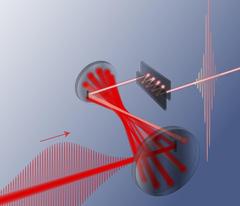URL: https://www.desy.de/news/news_search/index_eng.html
Breadcrumb Navigation
DESY News: Record compression delivers ultra-short laser pulses
News
News from the DESY research centre
Record compression delivers ultra-short laser pulses
With the help of a special “light compressor”, a team of researchers has produced ultrashort laser pulses at DESY. In collaboration with colleagues from Sweden and France, scientists led by Christoph Heyl from DESY and the Helmholtz Institute Jena succeeded in compressing high-energy laser pulses of about one third of a millimetre in length to under a hundredth of a millimetre in just one step. “This corresponds to a factor of almost 40, a new record for a single compression stage for high-energy laser pulses,” says Heyl. Around 80 percent of the energy of the original laser pulse was retained. In a further step, the researchers compressed the pulses to only about 4 thousandths of a millimeter (micrometre), which is about one tenth of the thickness of a human hair. The team presents its work in the journal Optics Letters.

The originally monochromatic infrared laser pulse (left) passes through the krypton gas several times, expanding its color spectrum, and is then compressed with special mirrors. Credit: Helmholtz Institute Jena/DESY, Christoph Heyl
The researchers started with laser pulses of 1.2 trillionths of a second (picoseconds) duration. That is inconceivably short already, but not short enough for the desired applications. To meet the specifications, the scientists sent the pulses into a two-metre-long mirror tube filled with krypton gas. In this tube, the interaction with the krypton gas slightly broadens the colour spectrum of the initially almost monochromatic infrared laser light each time it passes through the tube, a vital prerequisite for the following compression. After the pulses had passed the tube 44 times, they were coupled out and compressed with the help of special mirrors, shrinking them to just 32 quadrillionths of a second (femtoseconds), which corresponds to a length of about one hundredth of a millimetre. “We demonstrated this with a pulsed laser system which can provide an average power of 200 watts over a short time period. But we expect the method will also work with more powerful lasers,” reports Heyl. An ultra-short pulse laser system using the method described is currently being set up for plasma acceleration applications at DESY.
In a second step, the scientists sent the compressed laser pulses into another krypton tube. After twelve passes and another mirror compressor, the pulses were only 13 femtoseconds or 4 micrometers short, which corresponds to a total compression factor of about 90. “This is the first time that laser pulses with duration of only a few optical cycles have been generated by post-compression of picosecond pulses,” Heyl emphasizes. For the second step, however, the energy of the pulses had to be halved in order to protect the silver mirrors used in the krypton tube. In addition, only just under half the pulse energy was retained in the second stage. However, the researchers see numerous optimisation possibilities and deem operation with kilowatt lasers to be realistic. This would open up new possibilities for ultra-fast physics and plasma acceleration, among other things.
Researchers from the universities of Lund and Hamburg, the French Centre for Scientific Research CNRS, the Helmholtz Institute Jena and DESY were involved in the work.
Reference:
Post-compression of picosecond pulses into the few-cycle regime; Prannay Balla, Ammar Bin Wahid, Ivan Sytcevich, Chen Guo, Anne-Lise Viotti, Laura Silletti, Andrea Cartella, Skirmantas Alisauskas, Hamed Tavakol, Uwe Grosse-Wortmann, Arthur Schönberg, Marcus Seidel, Andrea Trabattoni, Bastian Manschwetus, Tino Lang, Francesca Calegari, Arnaud Couairon, Anne L’Huillier, Cord L. Arnold, Ingmar Hartl und Christoph M. Heyl; Optics Letters, 2020; DOI: 10.1364/OL.388665



